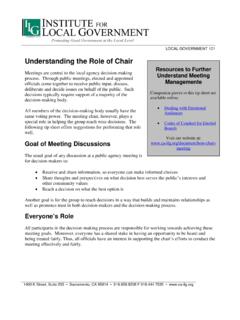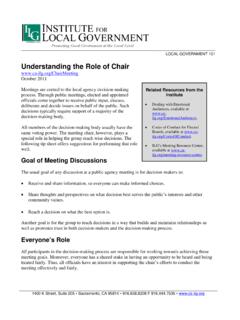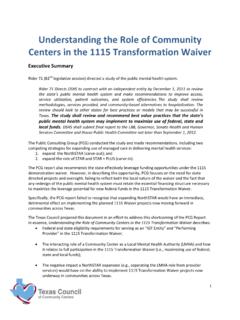Transcription of Understanding the Role of Community in Crowdfunding Work
1 Understanding the Role of Community in Crowdfunding Work Julie S. Hui Segal Design Institute Northwestern University Evanston, IL USA Michael D. Greenberg Segal Design Institute Northwestern University Evanston, IL USA Elizabeth M. Gerber Segal Design Institute Northwestern University Evanston, IL USA ABSTRACT Crowdfunding provides a new opportunity for entrepre-neurs to launch ventures without having to rely on tradi-tional funding mechanisms, such as banks and angel invest-ing. Despite its rapid growth, we understand little about how Crowdfunding users build ad hoc online communities to undertake this new way of performing entrepreneurial work. To better understand this phenomenon, we performed a qualitative study of 47 entrepreneurs who use crowdfund-ing platforms to raise funds for their projects. We identify Community efforts to support Crowdfunding work, such as providing mentorship to novices, giving feedback on cam-paign presentation, and building a repository of example projects to serve as models.
2 We also identify where com-munity efforts and technologies succeed and fail at support-ing the work in order to inform the design of Crowdfunding support tools and systems. Author Keywords Crowdfunding ; Community ; support tools; entrepreneurship; crowd work; distributed work. ACM Classification Keywords [Group and Organization Interfaces]: Design General Terms Design INTRODUCTION Entrepreneurship is often collaborative work sharing in-formation, resources, and connections in order to exploit new opportunities [43]. Such collaborations have accelerat-ed over the past few decades as the Internet has created new opportunities for exchange, especially among geographical-ly distributed collaborators. Crowdfunding has emerged as the most recent Internet based technology to support Community in entrepreneur-ship. Crowdfunding the online request for resources from a distributed audience often in exchange for a reward [16] provides a new way for entrepreneurs to solicit financial support from a distributed network that can range in size from dozens to thousands of supporters.
3 Crowdfunding platforms, such as Kickstarter, invite entre-preneurs to bring projects big and small to life by launching a fundraising campaign on their platform [24]. They herald successful examples on their websites, such as the team that raised more than $10,000,000 in a month from 60,000 supporters to manufacture and distribute a video game console [53] and another team that raised over $30,000 from 2,000 supporters to design and produce an eco-friendly pencil [54]. Entrepreneurs, particularly novic-es with limited networks and proven track records, have accepted the invitation, launching more than 1 million pro-jects in 2011 [13]. Despite the popularity of Crowdfunding , our empirical un-derstanding of the cooperative work practices involved in this system is limited. As researchers of computer support-ed cooperative work (CSCW), we aim in this paper to un-derstand the collaborative efforts and day-to-day activities of Crowdfunding users to design and improve Crowdfunding support tools [36].
4 We began our study by asking the ques-tion: What is the work of Crowdfunding ? Once we identified a growing theme of Community , we added the question: Permission to make digital or hard copies of all or part of this work for personal or classroom use is granted without fee provided that copies are not made or distributed for profit or commercial advantage and that copies bear this notice and the full cita-tion on the first page. Copyrights for components of this work owned by others than ACM must be honored. Abstracting with credit is permitted. To copy otherwise, or republish, to post on servers or to redistribute to lists, requires prior specific permis-sion and/or a fee. Request permissions from CSCW'14, February 15 - 19 2014, Baltimore, MD, USA Copyright 2014 ACM 978-1-4503-2540-0/14/02!$ Figure 1: A campaign page on the Crowdfunding platform, Kickstarter. What role does Community play in Crowdfunding work?
5 In order to understand existing technologies that support the work involved [47], we asked: What current technologies support Crowdfunding work? And how can they be improved? Through a qualitative study of 47 Crowdfunding users, we found that they carry out five main types of work preparing the campaign material, testing the material, pub-licizing the project, following through with project goals, and reciprocating resources to the Community . During each stage of work, they collaborate with others -- soliciting and giving advice based on their Crowdfunding experience, en-gaging donors in online conversation, and encouraging their social network to spread the word [30]. In addition to using general computer mediated planning and creative tools, such as email, group calendars, and video editing software, users have also started using Crowdfunding -specific tools, such as Crowdfunding project search websites and supporter management platforms.
6 By Understanding how these com-munity efforts and technologies succeed and fail at support-ing Crowdfunding work, we can identify how to better de-sign tools that support collaboration within the crowdfund-ing Community . We organized the paper into three sections. The first section introduces Crowdfunding work and related research. The second section presents our findings, identifying and de-scribing Crowdfunding work, the role of Community , and existing technologies used. The third section discusses de-sign implications and the need for tools and systems that facilitate the work practices. Crowdfunding The first Crowdfunding platform was launched in 2001 [52] and has grown to over 452 platforms worldwide [13]. These platforms use existing systems to facilitate the exchange of resources between entrepreneurs and supporters, such as web-based payment systems ( Amazon Payments), mes-saging systems ( comment threads), social media ( Facebook) and video sharing platforms ( YouTube) to raise awareness about the project.
7 Unlike traditional fund-raising methods, such as applying for funds from banks or foundations, Crowdfunding allows creators, people who request resources, to appeal for funds directly from sup-porters, people who give resources, without giving up pro-ject ownership [16]. In order to start a Crowdfunding campaign on an online platform, creators develop a project profile, which typically includes a title, video, description of planned use of funds, funding goal, campaign duration, and reward descriptions. Creators fill out these recommended and required fields online, and if the project is approved, the Crowdfunding platform posts their work in a pre-formatted public page where supporters can choose to donate (see Figure 1). RELATED WORK We found that Crowdfunding is a type of entrepreneurial work that relies heavily on Community building, distributed work, and crowd work.
8 We review relevant literature in these related areas. Entrepreneurial Work Entrepreneurial work involves the discovery, evaluation, and exploitation of opportunities to introduce novel prod-ucts, services, and organizations [42,43,48]. Entrepreneurs assess opportunities through psychological and environ-mental factors such as one s risk aversion and employment status [43]. When obtaining resources, scholars find that the majority of entrepreneurs use their own savings either out of necessity or to maintain control [3]. Entrepreneurs then exploit opportunities by creating a new firm or market mechanisms [43] through the organization of equipment, employees, production processes, and legal obligations [48]. Although scholars argue that the act of discovering entre-preneurial opportunities is a solitary endeavor, the exploita-tion of the entrepreneurial opportunity is often collaborative [43].
9 Entrepreneurs work in teams or form alliances with partnering organizations to benefit from other people s skillsets and to ease the workload [20,27,29,39]. However, entrepreneurs primarily collaborate to maintain a competi-tive advantage over other entrepreneurs, and therefore rare-ly share their best practices with the public [43]. This com-petitive environment makes it difficult for entrepreneurs to engage with communities in an open manner, which is con-sidered a common practice in Crowdfunding . Therefore, while crowdfunders also coordinate efforts and exploit op-portunities to follow through with their project goals, they are more open about their process and interact more closely with their Community to achieve their work. Online Communities Online communities are any virtual space where people interact to converse, exchange information or resources, learn, or play [38].
10 In these spaces, members can contribute to the Community growth by performing menial tasks, such as voting, or coordinating content production, such as man-aging a forum. Kraut identifies five main design challenges to create and maintain online communities, including start-ing up the Community , attracting members, motivating commitment, motivating contributions, and regulating Community health and wellness. Similar to Crowdfunding project creators, Community designers overcome these chal-lenges by deciding what content to post, communicating with members, and offering feedback and rewards to mem-bers [38]. To motivate people to join, scholars stress that Community leaders should reach out to potential members personally [32,33], send clear and easy to act on messages, get high status or a critical number of people to join the cause [19,33], give evidence that membership will make a differ-ence on Community wellbeing [31], and show that there is an urgency to join [31].









